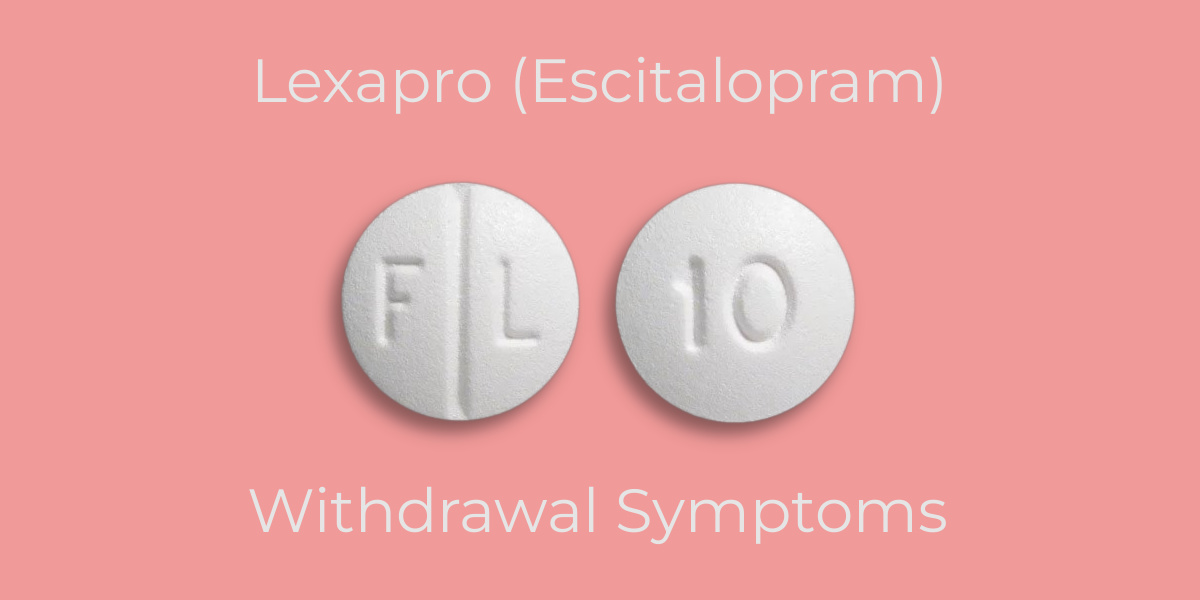Lexapro is a brand name for the antidepressant medication escitalopram, which is used to treat major depressive disorder and generalized anxiety disorder. When stopping Lexapro (escitalopram) treatment, it is common to experience some physical and emotional effects, known as withdrawal symptoms or discontinuation syndrome.

Does Lexapro cause withdrawal symptoms?
Studies show that between 20-85% of individuals stopping an antidepressant medication, such as Lexapro (escitalopram), experience withdrawal symptoms.[1][2][3] There may be a higher risk of withdrawal symptoms if the medication is stopped suddenly and after prolonged treatment.[4]
Antidepressants work by impacting neurotransmitter levels, which contributes to their psychological effects. Lexapro (escitalopram) is a selective serotonin reuptake inhibitor (SSRI), so it primarily affects serotonin levels. Serotonin impacts several bodily functions, including mood regulation, appetite, sleep, and cognition.
As such, when Lexapro (escitalopram) is reduced, the body must adapt to the changes in neurotransmitter levels and functioning. With abrupt cessation, there is a sudden change in serotonin levels, which creates several physical, emotional, and cognitive effects. To help prevent this, a gradual dose reduction is recommended.[5][6]
The half-life of a medication is likely to impact the risk and severity of withdrawal symptoms. Lexapro (escitalopram) has a half-life of 27-32 hours. This means that it takes 27-32 hours for half of the medication to leave the body and up to a week to be completely excreted.[7][8]
Medications with a short half-life have a high risk of withdrawal symptoms, as the effects of these medications stop much quicker following discontinuation than those with a long half-life. As it has a fairly short half-life, Lexapro (escitalopram) causes a moderate risk of antidepressant withdrawal symptoms.[4]
Lexapro withdrawal symptoms
When stopping an antidepressant, it is common to experience some mild withdrawal symptoms. These effects will likely be alleviated within two to three weeks without the need for intervention.
Lexapro (escitalopram) withdrawal symptoms can include: [1][7][8][9]
- Nausea
- Vomiting
- Diarrhea
- Stomach pain
- Headaches
- Dizziness
- Fatigue
- Extreme tiredness
- Appetite changes
- Flu symptoms
- Odd sensations in the brain that feel like electric shocks or ‘zaps’
- Shaking
- Tingling in the hands or feet
- Mood changes
- Anxiety
- Tearfulness
- Feeling restless
- Irritability
- Insomnia
- Vivid dreams
Some people experience very severe withdrawal symptoms that do not resolve quickly. Symptoms that have a significant impact on daily functioning, persist for longer than a month or become concerning should be reported to the prescribing clinician.
Severe Lexapro (escitalopram) withdrawal symptoms can include:[1][2][3][5]
- New or worsening thoughts of suicide
- Severe anxiety or depression symptoms
- Mania
- Aggression or violence
- Panic attacks
- Psychotic symptoms
- Vomiting or diarrhea that does not improve
- Falls or fainting due to dizziness
- Severe or persistent pain or headaches
- Persistent sleep difficulties or disturbances
- Seizures
- Ongoing sexual dysfunction
Lexapro withdrawal timeline
When stopping or reducing Lexapro (escitalopram) or other antidepressants like sertraline, withdrawal symptoms are likely to emerge within 1-5 days. If the dosage is reduced very slowly, it may take longer for symptoms to emerge, if at all.
Within the first two weeks of medication cessation, symptoms are likely to be at their most severe. For most people, withdrawal symptoms will reduce and resolve within two to three weeks.[4]
Some people may continue to experience withdrawal symptoms for longer periods, sometimes up to several months. These long-lasting withdrawal symptoms, known as post-acute withdrawal syndrome (PAWS) may be mild or more severe.
In a small number of instances, withdrawal symptoms could continue for many months or even years. It is not known what causes long-term withdrawal symptoms, although prolonged and high-dosage treatment could increase this risk.[9][10]
Lexapro cessation timeline
It is recommended to reduce Lexapro (escitalopram) dosage gradually over several weeks or months. Safe cessation can vary depending on the individual’s dosage, duration of treatment, condition, and response to dosage reductions.[9]
During cessation, your doctor will closely monitor any physical or emotional symptoms you experience, to reduce your medication safely and with the lowest risk of severe withdrawal symptoms.[7]
Depending on your reaction to each dose reduction, cessation can involve up to 50% dose reduction every 2-4 weeks.[4]
A typical Lexapro (escitalopram) dosage is 10mg or 20mg per day. A timeline from 20mg per day to complete cessation could involve the following dosage reductions:
- Week 1 and 2: 10mg per day
- Week 3 and 4: 5mg per day
- Week 5 and 6: 2.5mg per day
- Week 7 and 8: 1.25mg per day
- Week 9 and 10: 0.6mg per day
- Week 11: Complete cessation
During this time, if withdrawal symptoms become more severe or problematic, the dosage can be reduced in smaller increments or more slowly until these symptoms are reduced. Conversely, some people might experience very few or no withdrawal symptoms and manage a reduction from 2.5mg or 5mg per day to complete cessation.[11]
It is essential to communicate with your doctor during this process and inform them of any withdrawal symptoms you experience. They can then make any necessary adjustments to your prescription or advise on how best to manage your symptoms.
Lexapro detox treatment
Lexapro (escitalopram) is often prescribed to treat mental health conditions such as major depressive disorder (MDD) and generalized anxiety disorder (GAD).[8] As such, it may be necessary to arrange alternative treatment or support during and after stopping this medication to manage or prevent a relapse of symptoms.
The effects of stopping antidepressant treatment may be reduced or managed with the use of the following self-care techniques:[6][7][12]
- Understanding the risks: Knowing the potential effects of stopping Lexapro (escitalopram) can help reduce concerns and ensure appropriate planning before and during the cessation process.
- Engaging in calming activities: Relaxation exercises and calming activities can help ease physical and emotional distress that may occur during this time. This can include listening to music, walking in nature, spending time on hobbies, breathing exercises, yoga, and meditation.
- Healthy lifestyle habits: Ensuring you look after your physical well-being can reduce the physical and emotional effects of reducing your medication. This could include regular exercise, avoiding caffeine and alcohol, healthy eating, and following a sleep schedule.
- Talking to others: It can be beneficial to utilize your support network of friends and family or attend counseling sessions. This can help with managing any emotional challenges during this time and help to prevent a relapse of mental health symptoms.
- Following your doctor’s advice: Ensure that you closely follow the cessation plan set out by your doctor to reduce any potential risks. Do not skip doses or take more or less than is prescribed, as this can cause adverse effects and increase the risk of withdrawal symptoms.


-guide-detail.jpg?v=1722503452)
-guide-detail.jpg?v=1722503424)
-guide-detail.jpg?v=1722503337)